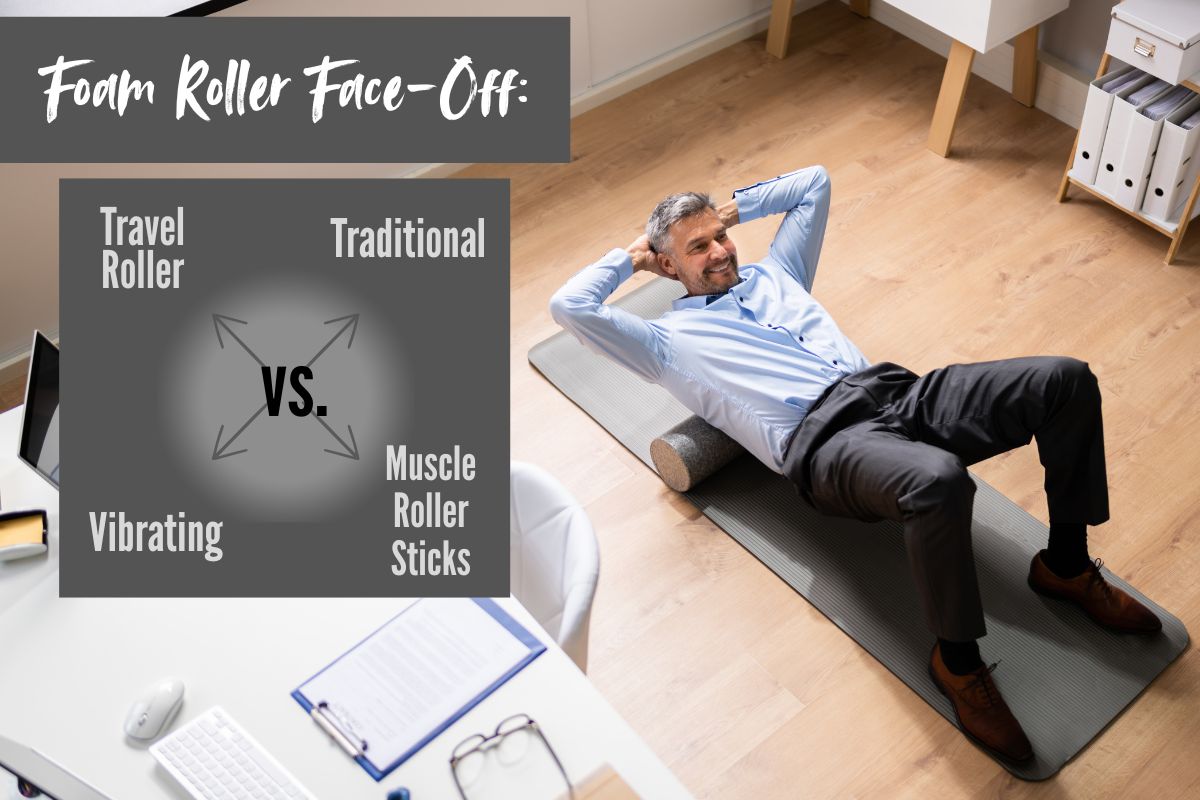Your Cart is Empty
🎁 Holiday Sale | 15% Off Almost Everything | Discount Applies at Checkout 🎁
🎁 Holiday Sale | 15% Off Almost Everything | Discount Applies at Checkout 🎁
Shop
Products
Rolling It Out: Comparing Foam Rollers, Muscle Sticks & the Travel Roller
April 28, 2025 4 min read

In recent years, recovery has become just as critical as the workout itself, with athletes and fitness enthusiasts prioritizing muscle repair, flexibility, and injury prevention. At the forefront of this movement are self-myofascial release (SMR) tools—particularly foam rollers—which have surged in popularity for their ability to alleviate soreness and improve mobility. But with so many options on the market, not all rollers are created equal. From high-density foam to vibrating tech and portable designs, each type offers unique benefits and drawbacks depending on your fitness goals, budget, and lifestyle. So, how do you choose the right one? Let’s break it down.
Traditional Foam Rollers: The Classic Recovery Tool
When it comes to self-myofascial release, traditional foam rollers are the most accessible and budget-friendly option. These simple yet effective tools—like the Fitterfirst Classic Foam Roller or the ultra-firm Max High Density Roller—are great for general muscle recovery, helping to ease tightness in larger muscle groups like the quads, hamstrings, and back.
Pros:
✔ Affordable & widely available – You can find them at nearly any fitness or sporting goods store.
✔ Great for beginners – Their smooth surface provides a gentler introduction to self-massage compared to textured or vibrating rollers.
✔ Effective for general recovery – Ideal for post-workout soreness and light mobility work.
Cons:
✖ Bulky & not very portable – Their size makes them less convenient for travel or small living spaces.
✖ Limited pressure control – Softer rollers may not provide enough intensity for deep tissue work, while high-density options (like the Max High Density Roller) can be too intense for sensitive muscles.
Best for: Beginners, budget-conscious users, or those looking for a simple, no-frills recovery tool. If you need deeper relief or more versatility, however, you might want to explore other options.
Vibrating Foam Rollers: High-Tech Recovery
For those seeking next-level muscle relief, vibrating foam rollers combine traditional myofascial release with percussive massage therapy to enhance recovery. Models like the Power Plate Vibrating Roller use rapid vibrations to penetrate deeper into muscle tissue, helping to break up stubborn knots, improve blood flow, and accelerate relaxation.
Pros:
✔ Enhanced muscle relief – Vibration helps loosen tight muscles more effectively than static rolling alone.
✔ Improved circulation & recovery – Great for reducing stiffness and speeding up post-workout repair.
✔ Ideal for chronic tightness – A game-changer for athletes, lifters, or anyone with persistent muscle tension.
Cons:
✖ More expensive – Typically cost significantly more than traditional rollers.
✖ Requires charging – Less convenient than passive rollers, and the added tech makes them heavier.
Best for: Serious athletes, gym-goers with stubborn muscle adhesions, or anyone willing to invest in advanced recovery tech. If you're dealing with deep-seated tension or want a spa-like massage at home, a vibrating roller is worth the splurge.

Travel Roller: Compact & Pro-Grade Recovery On the Go
For fitness enthusiasts who demand portability without sacrificing performance, the Travel Roller (from another Canadian owned brand) is a game-changer. Its hollow core isn’t just for lightweight convenience—it doubles as storage for small recovery tools like acupressure balls or resistance bands, keeping everything in one place. The tube cover has grippy textured foam to deliver deep, targeted pressure, making it a favourite among athletes and physiotherapists. Plus, its removable, washablecover ensures hygiene after intense sessions.
Pros:
✔ Ultra-portable & space-saving – Perfect for gym bags, travel, or small apartments.
✔ Pro-level intensity – Firmer than standard rollers for deeper tissue release.
✔ Smart storage design – Keep small recovery accessories neatly tucked inside.
Cons:
✖ May be too intense for beginners – The high density requires some experience with self-myofascial release.
Best for: Frequent travelers, mobile athletes, or anyone who wants serious muscle relief in a compact package. If you’re tired of flimsy portable rollers and want clinic-grade pressure on the go, this Canadian-engineered design is a standout pick.
Tip: Use the hollow core to stash a lacrosse ball or massage cream for a complete recovery kit anywhere!
Muscle Roller Sticks (e.g., Tiger Tail): Pinpoint Relief Anywhere
When you need quick, targeted relief without the bulk, muscle roller sticks like the Tiger Tail are a must-have. These compact, handheld tools let you easily massage smaller muscle groups—think calves, quads, arms, and even feet—whether you're sitting at your desk or standing pre-workout. The ultra-portable Roadster model (just 11" long) slips effortlessly into a gym bag, making it perfect for travel or on-the-spot tension relief.
Pros:
✔ Lightweight & travel-friendly – No setup needed, just grab and roll.
✔ Versatile positioning – Works seated, standing, or even mid-flight.
✔ Ideal for warm-ups & quick fixes – Great for loosening tight spots before or after training.
Cons:
✖ Less intense than bodyweight rollers – Relies on arm pressure, so it won’t dig as deep as a foam roller.
Best for: Runners, travelers, office workers, or anyone who wants fast, convenient relief without the floor workout. Keep one in your car, bag, or desk for instant muscle maintenance!
Conclusion: Choosing the Right Roller for Your Recovery Needs
From the budget-friendly simplicity of traditional foam rollers to the high-tech relief of vibrating models, the portable intensity of travel rollers, and the on-the-go convenience of muscle sticks, there’s a self-myofascial release tool for every need. Your choice ultimately depends on your fitness goals, lifestyle, and recovery preferences—whether you’re a serious athlete seeking deep tissue work or someone who just needs quick tension relief between meetings. Investing in the right roller can enhance recovery, improve mobility, and keep you performing at your best. So, pick your tool, roll out those knots, and recover smarter!
Subscribe
Sign up to get the latest on sales, new releases and more …

